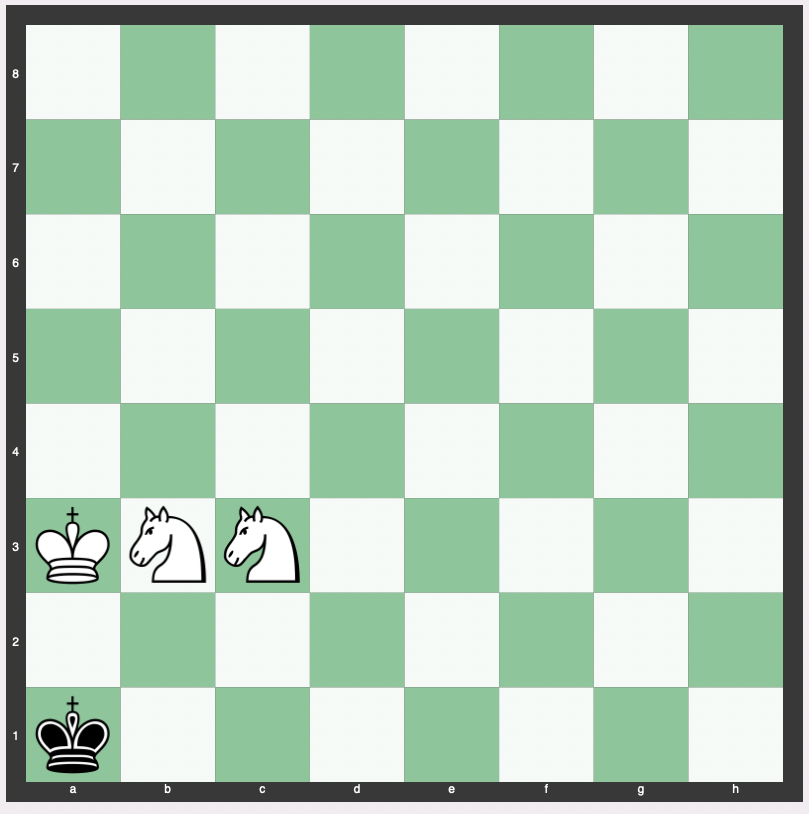One endgame scenario that has intrigued chess enthusiasts for centuries is the “Two Knights & King vs. King” setup, or the Two Knights Endgame.
Theoretically, the two knights endgame (a scenario where two knights and a king are pitted against a lone king) is a draw. This is attributed to the inherent limitation of the two knights. They are incapable of orchestrating a situation where the adversary king is maneuvered into a checkmate position with all potential escape squares being controlled by the knights and their allied king, before either succumbing to a stalemate or losing one of the knights.
A checkmate is possible in the Two Knight Endgame, but can’t be forced.
Below we look into the nuances of this setup, exploring whether it leads to a draw or a checkmate.
Understanding the Chessboard
The Power of the Knights
Before we venture into the specifics of the scenario, it is essential to understand the unique abilities of the knights in a chess game.
Knights move in an ‘L’ shape, which can be a combination of two squares in one direction and one square perpendicular to that.
This unique movement pattern can sometimes create complex situations on the board.
The King’s Role
The king, although not as agile or powerful as other pieces, holds the key to the game.
In the endgame, the king transforms from a piece to be protected to an active participant, fighting to secure a favorable outcome.
The Two Knights & King vs. King Scenario
Theoretical Analysis
The “Two Knights & King vs. King” scenario is a classic study in chess theory.
According to the theory, this setup of two knights and a king against a king generally leads to a draw because the two knights are unable to create a position where the opposing king is forced into a checkmate where all squares can be covered by the two knights and king before losing one of the knights or before a stalemate is forced.
However, it’s possible that checkmate can be achieved if the player with the lone king blunders into it.
That’s why the game doesn’t end on the spot due to insufficient material in the Two Knights Endgame, as it would with just a single knight and king versus a king.
Practical Implications
In practical gameplay, attempting to secure a checkmate in this scenario can be an arduous task.
The player with the two knights would need to demonstrate exceptional skill in maneuvering their pieces to corner the opposing king successfully and hope for a mistake from their opponent.
Strategies to Consider in the Two Knights Endgame
Coordinated Movement
To stand a chance at securing a victory, the player with the two knights must employ a strategy of coordinated movement.
This involves using the knights and the king in tandem to control and dominate sections of the board gradually.
An example would be the following:
Let’s say the black king is on the edge of the board like this and the white king and knights are positioned as such:
To avoid checkmate black needs to go to the inside of the board:

However, if black blunders and goes to the corner, it’s checkmate in one:

Another example would be if black has an extra pawn.
This means white does not have to worry about stalemate and can potentially checkmate the black king before a stalemate happens (and before the pawn promotes to get a strong piece and swing the position).
Forcing a Stalemate
On the other hand, the player with the lone king should aim to force a stalemate.
This can be achieved by moving the king to a corner of the board where it is harder to be checkmated, and by avoiding moves that would allow the opponent to force a checkmate.

Another variation where the king is not in check and can’t move:

Two Knights Endgame with Supporting Pieces
When there are other pieces on the board in a two knights endgame, then checkmate can certainly be more than theoretically possible but forced with optimal play.
Consider this position:

First, eliminate the other threatening pieces that can move:

Get the king positioned to cut off two escape squares. Slowly squeeze out the space.

Check with the knight. This will also cut off the a7 escape square.

The pawn taking b4 will cut off the c5 escape square. The king is now just limited to b5. Like always, be sure to check for any stalemate scenarios before you move. If not in check, be sure the king still has legal moves remaining.

With the check from the c-pawn, only a6 is remaining.

Now we can deliver the checkmate with either the pawn or the knight to c5.

The final checkmate position checkmating with the knight.

Example #2
Another variation of the two knights checkmate:

Conclusion
The “Two Knights & King vs. King” scenario (Two Knights Endgame) presents a fascinating glimpse into the complex and rich world of chess endgames.
Theoretically, this setup leans towards a draw, as achieving a checkmate with just two knights and a king is a highly complex and rare occurrence.
However, with skillful play and strategic maneuvering, a checkmate, although unlikely, is not entirely impossible.
Related


